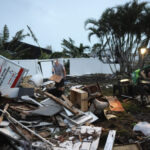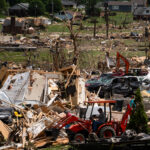Wyoming’s workplace safety office is adopting new safety rules for oil and gas drilling during a year in which accidents have killed five of the industry’s workers in the state.
Wyoming consistently ranks among the most dangerous states for workers, largely due to accidents in the oil and gas industry. Among other changes, the new rules prohibit smoking within 75 feet of a well bore and require rig workers to get annual fire extinguisher training.
A public comment period on the proposed rules began in mid-October and continues through November. A public hearing on the proposed rules is scheduled for Dec. 2 in Casper before the Wyoming Occupational Safety and Health Commission.
If the commission votes to approve the rules at the December meeting, they would then go to Gov. Matt Mead for approval within 75 days.
The new rules didn’t result from any particular accident, and work on them began last year, said J.D. Danni, OSHA program manager for Wyoming.
The rules were last updated in 1999, and the changes are a result of collaboration between the state and a petroleum industry group, the Wyoming Oil and Gas Industry Safety Alliance.
“We’re working more closely with industry in getting that feedback,” Danni said Friday. “This is just part of catching up with some of the industry as well as some of the things we have seen in the last 5-10 years.”
Other rule changes include requiring workers to wear flame-resistant clothing within 75 feet of a well bore, new requirements for companies to document safety training, and new procedures for planning to call for help during an emergency.
In August, three men died when two tanks holding oil and water exploded northeast of Casper. Accidents on drilling rigs killed two others in Wyoming this year: In January, an exploding pipe killed a worker at a rig in the Pinedale area, and in February, a man died a couple weeks after falling 60 feet form an oil rig in Converse County.
Oil and gas industry accidents killed 62 people in Wyoming from 2001 to 2008. Thirty-two of those deaths resulted from accidents on oil and gas rigs.
Twenty-five others in the oil and gas industry were related to transportation, according to Timothy Ryan, an epidemiologist in the governor’s office who specializes in workplace safety.
Ryan said he didn’t have data to be able to say if this year is shaping up to be an especially bad one or not for oil and gas accidents, but thinks the state OSHA office and industry are working well together to improve safety regardless.
“I think these rules that are put forth are a good indication of that, to identify best practices and to share within the industry best practices and sort of lessons learned, things that have gone wrong and things that have worked particularly well,” he said.
The safety rule update for workers on drilling rigs will be followed next year by updates to the safety rules for well servicing – work done down a well bore after initial drilling.
A third round of updates will focus on other types of well servicing, such as pumping cement to reinforce a well. The state then will revisit the drilling safety rules again in a few years, Danni said.
“We’re trying to get an ongoing type of progression to address these and update them and slowly tweak them as we need to,” he said.
Was this article valuable?
Here are more articles you may enjoy.

 Here Comes Another Busy Atlantic Hurricane Season, But Will It Be as Crazy as 2024?
Here Comes Another Busy Atlantic Hurricane Season, But Will It Be as Crazy as 2024?  Trump Administration Targets Resiliency Funds to Shrink FEMA’s Role
Trump Administration Targets Resiliency Funds to Shrink FEMA’s Role  Hackers Abuse Modified Salesforce App for Data Theft and Extortion, Google Says
Hackers Abuse Modified Salesforce App for Data Theft and Extortion, Google Says  We Have Entered A New Era of Auto Claims Complexity
We Have Entered A New Era of Auto Claims Complexity 